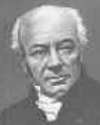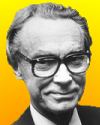
On 15 Aug 1910, Constantin Fahlberg died, the Russian chemist who, while working for Ira Remsen on coal tar compounds, discovered saccharin, a compound 220 times sweeter than cane sugar. Fahlberg coined the name “saccharin” by which this artificial sweetener is now known - and it may be a surprise to you that it has been manufactured since as long ago as 1896, when Fahlberg set up a factory to produce it.
How did Fahlberg discover it? Well, by a fluke, while researching in his chemistry lab on unrelated work. The story of that serendipitous accident is interesting, and you can read about it in a longer article on The Inventor of Saccharine from a Scientific American issue in 1886.

On 15 Aug 1857, a bill was passed by the Italian parliament authorizing the boring of the Mont Cenis Tunnel, eight miles long, through the Alps between Modane and Bardonnêche. When work began, only hand drilling methods were available, and that was laboriously slow—the first year only about 1500 feet was excavated. But by 1861, the French engineer Germain Sommeiller introduced pneumatic drills which more than tripled the progress.
But just how can tunnels meet when bored from two sides of a mountain? That is the topic of a short article on Surveying the Mont Cenis Tunnel.
The triumph of engineering machinery that completed the tunnelling is explained in a section of Discoveries and Inventions of the Nineteenth Century (1903). Illustrations of the boring machinery and the former steep switchback road over the mountain have been added to the webpage for this description of the Mont Cenis Tunnel.
The human side of the operation can be read in a chapter from Underground: or Life Below the Surface (1876). In our modern era of rock-chewing TBMs (Tunnel Boring Machines), it is a startling reality check to see the illustration of the conditions under which the men worked, a century and a half ago, and yet accomplish an eight-mile tunnel under the Alps.
Reading these pieces will be well worth your time for you'll gain a sense of admiration for the men, both workers and inventor, of that era!

On 15 Aug 1914. the Panama Canal was officially opened by an American ship sailing from the Atlantic to the Pacific Ocean by the short route that avoided the long path around South America and the sometimes stormy Cape Horn. Of course, on a map, it might seem a no-brainer - and a simple task - to cut a waterway across the narrow neck of land between the North and South Americas. But of course, it wasn’t all that simple. That narrow bit on the map is fifty-one miles with oppressive heat in a vast malarial swamp. the best-selling historian, the best-selling historian. With his well-known flair for dramatic, yet altogether accurate and gripping story-telling, McCullough reveals more about the awesome task of this construction task than you’d ever learn from a TV documentary.
It is available from Amazon, typically about New from $6.70. Used from $2.19. (As of earlier time of writing - subject to change.)
 | Vulnerable, like all men, to the temptations of arrogance, of which intellectual pride is the worst, he [the scientist] must nevertheless remain sincere and modest, if only because his studies constantly bring home to him that, compared with the gigantic aims of science, his own contribution, no matter how important, is only a drop in the ocean of truth. |
 | Geology has shared the fate of other infant sciences, in being for a while considered hostile to revealed religion; so like them, when fully understood, it will be found a potent and consistent auxiliary to it, exalting our conviction of the Power, and Wisdom, and Goodness of the Creator. |
 | The literature [Nobel] laureate of this year has said that an author can do anything as long as his readers believe him. A scientist cannot do anything that is not checked and rechecked by scientists of this network before it is accepted. |
| Before you look at today's web page, see if you can answer some of these questions about the events that happened on this day. Some of the names are very familiar. Others will likely stump you. Tickle your curiosity with these questions, then check your answers on today's web page. | |
| Births | |
 | Louis-Victor de Broglie, born 15 Aug 1892, was a French physicist best known for his research on quantum theory. For this, he was awarded the 1929 Nobel Prize for Physics. What was his most famous discovery? |
 | Thomas Edward (T.E.) Lawrence, born 15 Aug 1888, was a British scholar, military strategist, and author best known for his legendary war activities in the Middle East during WW I and for his account of those activities in The Seven Pillars of Wisdom (1926). In which scientific field was he a scholar? |
| Deaths | |
 | Wiley Post (1900-1935) was one of the most colourful figures of the early years of U.S. aviation. He set many records. In Jul 1933, he made his most famous flight in his Lockheed Vega 5B single-engine aircraft Winnie Mae. He had made his first solo flight in 1926, the year he got his flying license, signed by Orville Wright, despite wearing a patch over his left eye, lost in an oilfield accident. What was this famous flight? |
| Events | |
 | On 15 Aug of a certain year, the Panama Canal was officially opened by an American ship sailing from the Atlantic to the Pacific Ocean. This new navigable connection across Central America saved sea trade from going all the way around South America’s sometimes stormy Cape Horn. Part of building the canal and lock system, was a massive artificial lake as part of the route. It was made by damming the Chagres River. It acts as a reservoir for water used in the canal locks. What is the name of this artificial lake? |
 | On 15 Aug 1906, a tunnel system, the first of its kind in the U.S., began operation underneath Chicago, Illinois. What was the purpose of the tunnels? |
 | In 1877, Thomas Edison suggested a telephone greeting to the president of the Telegraph Company to answer the phone instead of “Ahoy” suggested by Alexander Bell. What greeting did he suggest? |
Fast answers for the previous newsletter for August 14: sodium and potassium • Hans Christian Ørsted • Enzo Ferrari • Frederic Joliot-Curie • the decade including 1820 • whiffle ball.
 If you enjoy this newsletter, the website, or wish to offer encouragement or ideas, please send feedback by using your mail reader Reply button.
If you enjoy this newsletter, the website, or wish to offer encouragement or ideas, please send feedback by using your mail reader Reply button. Your click on a Facebook, StumbleUpon, or other social button on the site webpages is also a welcome sign of appreciation. Thank you for using them.
© This newsletter is copyright 2020 by todayinsci.com. Please respect the Webmaster's wishes and do not put copies online of the Newsletter — or any Today in Science History webpage. (If you already have done so, please remove them. Thank you.) Offline use in education is encouraged such as a printout on a bulletin board, or projected for classroom viewing. Online, descriptive links to our pages are welcomed, as these will provide a reader with the most recent revisions, additions and/or corrections of a webpage. For any other copyright questions, please contact the Webmaster by using your mail reader Reply button.
--
If you do not want to receive any more newsletters, Unsubscribe
To update your preferences and to unsubscribe visit this link
Executive Real Estate Business Class
-
"It was like a man with wings. It wasn't like anything you'd see on TV or in a monster movie." ...
About the publisher
Search This Blog
Blog Archive
-
▼
2021
(585)
-
▼
August
(32)
- Newsletter for Tuesday 31 August.
- Newsletter for Monday 30 August.
- Newsletter for Sunday 29 August.
- Newsletter for Saturday 28 August.
- Newsletter for Friday 27 August.
- Newsletter for Thursday 26 August.
- Newsletter for Wednesday 25 August.
- Newsletter for Tuesday 24 August.
- Newsletter for Monday 23 August.
- All-New Tonight: 'The Machines That Built America'
- Newsletter for Sunday 22 August.
- Newsletter for Saturday 21 August.
- Newsletter for Friday 20 August.
- Newsletter for Thursday 19 August.
- Newsletter for Wednesday 18 August.
- Newsletter for Tuesday 17 August.
- Newsletter for Monday 16 August.
- Newsletter for Sunday 15 August.
- Newsletter for Saturday 14 August.
- Newsletter for Friday 13 August.
- Newsletter for Wednesday 11 August.
- Newsletter for Tuesday 10 August.
- Newsletter for Monday 9 August.
- All-New Tonight 9/8c: Telephone Wars
- Newsletter for Sunday 8 August.
- Newsletter for Saturday 7 August.
- Newsletter for Friday 6 August.
- Newsletter for Thursday 5 August.
- Newsletter for Wednesday 4 August.
- Newsletter for Tuesday 3 August.
- Newsletter for Monday 2 August.
- Newsletter for Sunday 1 August.
-
▼
August
(32)
-
Blogroll
-
About
HistoryFact










0 comments:
Post a Comment